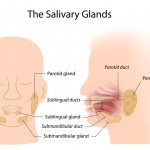
Oral cancer is a global major health burden (Dental Elf – 16th October 2020) with oral squamous cell carcinoma (OSCC) the most common type (Dental Elf – 29th June 2020). The average survival rate is 90% when detected early however, this drops to 50% with late detection (Yeung 2017). Saliva has been considered a diagnostic bio fluid with studies evaluating the performance of salivary biomarkers for the early detection and surveillance of OSCC.
The aim of this systematic review was to identify and summarise the diagnostic accuracy of salivary biomarkers used in the detection of OSCC in adults.
Methods
Only studies that evaluated salivary biomarkers and reported measures of diagnostic test accuracy such as sensitivity and specificity in detecting OSCC in adults suspected of having OSCC with no prior treatment (such as chemotherapy or radiotherapy) were included. In addition, studies needed to evaluate the performance of singular salivary biomarkers (index test) against any type of tissue biopsy with histopathological examination (as the reference standard). Studies assessing combined salivary biomarkers or patients with oral potentially malignant disorders were excluded.
The Cochrane Library, MEDLINE via OVID and Embase via OVVID were the databases searched from 2014 to 2018. A tailored QUADAS-2 tool was used to assess the quality of included studies.
Results
- Following removal of duplicates, 250 articles were retrieved across the initial database search. After implementation of the inclusion and exclusion criteria, 6 studies were included in the review. The included studies evaluated data from 775 patients; 355 patients for cytokeratin 19 fragment (CYFRA 21-1) and 420 for matrix metalloproteinase-9 (MMP-9).
- 356 patients were diagnosed with OSCC (46%) according to the reference standard of histopathological biopsy examination. This included 180 patients in CYFRA 21-1 studies and 176 in MMP-9 studies. The remaining patients were classed as disease-free or non-OSCC.
- The classification and reporting of OSCC varied across studies, making meta-analysis inappropriate. None of the included studies could be classified as low risk of bias across all four domains. Patient selection was considered high risk of bias in all studies. The index test was considered low risk of bias in one study, unclear in one study but high in four studies.
- Only three studies were assessed as being of low concern for applicability according to patient selection, the index test and reference standard. The remaining three studies were unclear concern for applicability.
- The sensitivity of CYFRA 21-1 (95% CI) ranged from 0.84 (0.75-0.91) to 0.94 (0.83-0.99) and specificity ranged from 0.84 (0.71-0.93) to 0.96 (0.80-1.00).
- The sensitivity of MMP-9 (95% CI) ranged from 0.76 (0.67-0.83) to 1.00 (0.78-1.00).
- The overall quality of included studies for both CYFRA 21-1 and MMP-9 was regarded as poor and limited by patient selection, a lack of assessors and small sample sizes.
Conclusions
The authors concluded: –
…due to the presence of biases and other limitations in the studies reviewed, there is no conclusive evidence of the value of singular salivary CYFRA 21-1 or MMP-2 analyses as screening tools for OSCC at the present time.
Comments
This systematic review only included a biomarker if it had three or more studies therefore, only two biomarkers, CYFRA 21-1 and MMP-9 were included. There are a wide range of OSCC salivary biomarkers reported in literature which have not been covered in this systematic review. As this is a novel area for research, the limited number of studies included limits the conclusions that can be drawn. The authors correctly acknowledged this and with the classification of OSCC varying between studies, meta-analysis was not possible. There is the need for a well-designed prospective study investigating salivary biomarkers for patients with OSCC to determine their diagnostic efficacy and translation into clinical practice.
Links
Primary paper
Other references
Yeung CA. Referrals to dentists by GPs could delay diagnosis of oral cancer. BMJ. 2017 Jan 10;356:i6784. doi: 10.1136/bmj.i6784. PMID: 28073743.
Dental Elf – 29th June 2020
Elective neck dissection versus observation for T1-2 oral squamous cell carcinoma
Dental Elf – 16th October 2020
Optical fluorescence imaging in oral cancer and potentially malignant disorders
